A Comprehensive Cyberbullying Guide for Parents

Digital technology is ubiquitous.
Nearly three-quarters of people in the UK say they’re on the internet at least twice a day.
For many of us, no doubt, it’s even more.
This has its advantages. We’ve got access to almost limitless information and we can communicate with anyone from anywhere in the world.
This won’t surprise parents, but children and teenagers are online a lot nowadays too.
Over 97% of teenagers in the US have access to a smartphone, and 54% say that it would be “hard” to give up social media altogether. In the UK, young people aged 8 to 17 report spending anything from 2.5 hours to 4.5 hours online per day.
Teens typically get a lot out of the internet. In a survey in the US, 80% said they feel more connected to friends because of it, and 67% felt like the internet helped them build a strong support network.
There are disadvantages, too.
The same survey found that 38% of teens felt overwhelmed by “drama” on social media, with 29% feeling pressure to get lots of interactions on their posts. Although it’s good to note that these numbers have dropped in recent years.
Cyberbullying is another big risk for children and teens who are spending more time than ever on the internet.
With seemingly every device we use able to connect to the web, it can seem impossible to get away from this potentially ugly side of the internet.
This cyberbullying guide for parents will help you ensure that your child stays protected when they get online. It will also give you helpful hints about what parents can do about cyberbullying, so that you can best help your child. Editor’s Note: We value our relationship with our readers, and we strive to earn your trust through transparency and integrity. We are in the same ownership group as some of the industry-leading products reviewed on this site: ExpressVPN, Cyberghost, Private Internet Access, and Intego. However, this does not affect our review process, as we adhere to a strict testing methodology.
What is Cyberbullying?
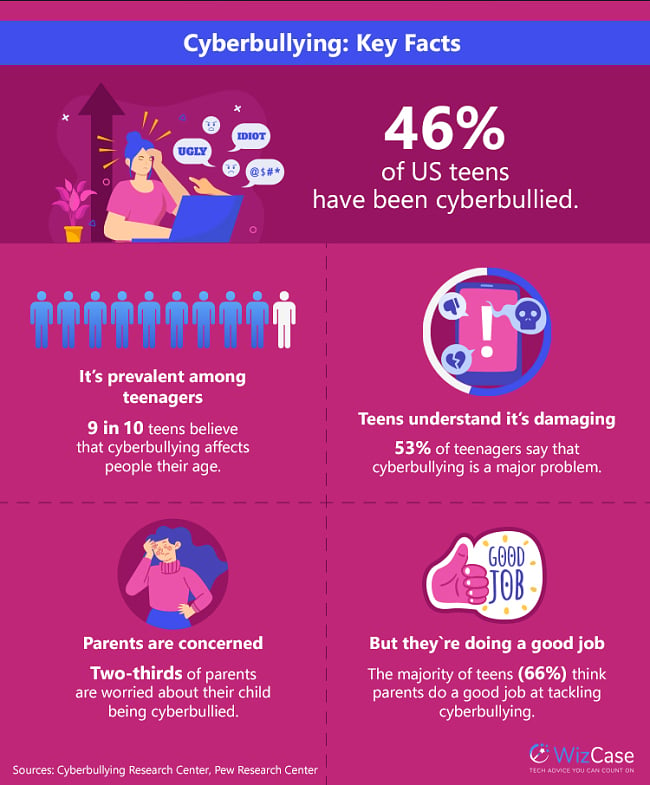
Sources:
Teens and Cyberbullying 2022 – Pew Research Center
A Majority of Teens Have Experienced Some Form of Cyberbullying – Pew Research Center
Children and Parents: Media Use and Attitudes Report 2023 – The Office of Communications (UK)
Defining “Cyberbullying”
The Cyberbullying Research Center, a US non-profit, provides the go-to definition for cyberbullying:
Cyberbullying is “willful and repeated harm inflicted through the use of computers, cell phones, and other electronic devices.”
This definition captures the most important factors at play.
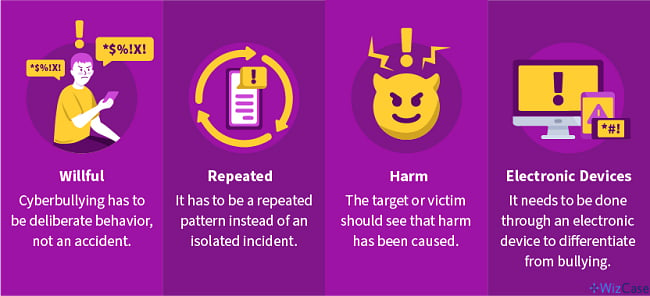
Other definitions make more of a distinction around the harm element, stipulating that cyberbullying must be behavior that’s meant to “hurt or embarrass” someone.
Perhaps a simpler definition is better for this cyberbullying guide for parents, though: cyberbullying is a form of bullying that takes place via digital media.
The UK’s Office for National Statistics (ONS) is responsible for producing and publishing the country’s official statistics. Introducing its most recent statistical release on cyberbullying in the UK, from 2021 UK Census data, ONS said:
“There is no legal definition of bullying, but it is often described as behavior that hurts someone else, physically or emotionally, and can happen anywhere – at school, at home or online.”
When we’re talking to children and teenagers about cyberbullying, it helps to define it in a way that’s relevant to their experience.
I think it’s really effective to do this in as collaborative a way as possible. There’s a good chance the children you care for know a lot more than you do about the nuts and bolts of cyberbullying today. Plus, these approaches bring a huge advantage in parenting, teaching, coaching, and mentoring.
TIP: Talking About Cyberbullying With Kids and Teens
The Cyberbullying Research Center says this when they talk about cyberbullying while surveying young people:
“Cyberbullying is when someone repeatedly makes fun of another person online or repeatedly picks on another person through email or text message or when someone posts something online about another person that they don’t like.”
Once you’ve explained this, you can talk in specifics about the kinds of behavior that cyberbullying might describe.
Be prepared to learn things that aren’t in this guide when speaking with your child! Cyberbullying takes on many forms and is changing all the time.
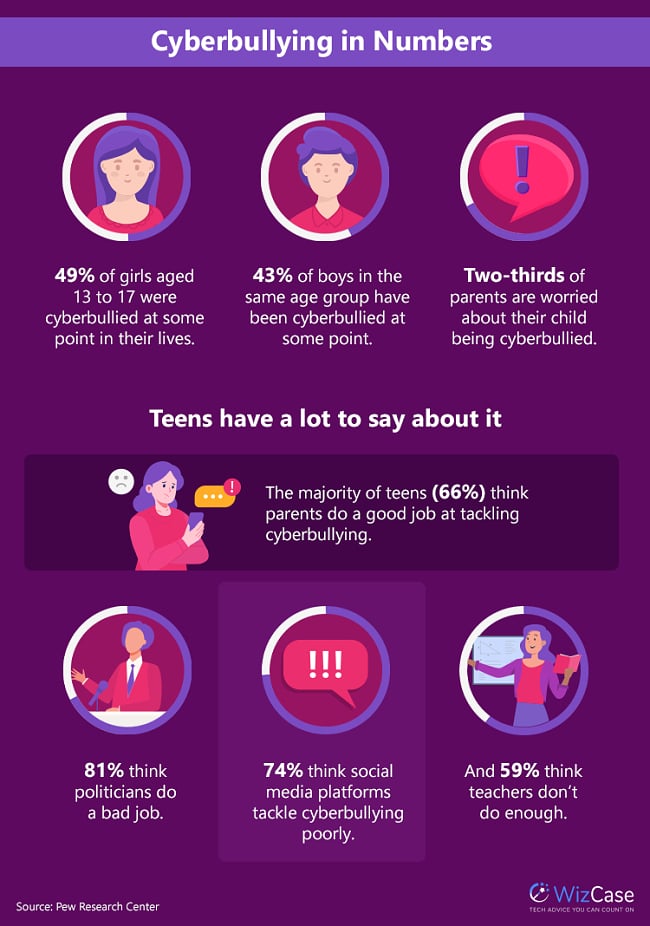
Sources:
Teens and Cyberbullying 2022 – Pew Research Center
Children and Parents: Media Use and Attitudes Report 2023 – The Office of Communications (UK)
Cyberbullying and Bullying Are Pretty Similar
It helps to think about cyberbullying in the context of bullying in general. They have a lot of the same elements and cause similar problems. The solution for one is usually relevant in addressing the other.
A lot of the time, when cyberbullying is happening, it’s also happening as a part of a wider in-person bullying problem. There are multiple papers demonstrating the close links between the different types of bullying offline and online, and parents should be aware of this.
TIP: The Link Between Cyberbullying and Bullying
If your child is being bullied, there’s a very good chance they’re being cyberbullied.
There are also a few key differences that set cyberbullying apart.
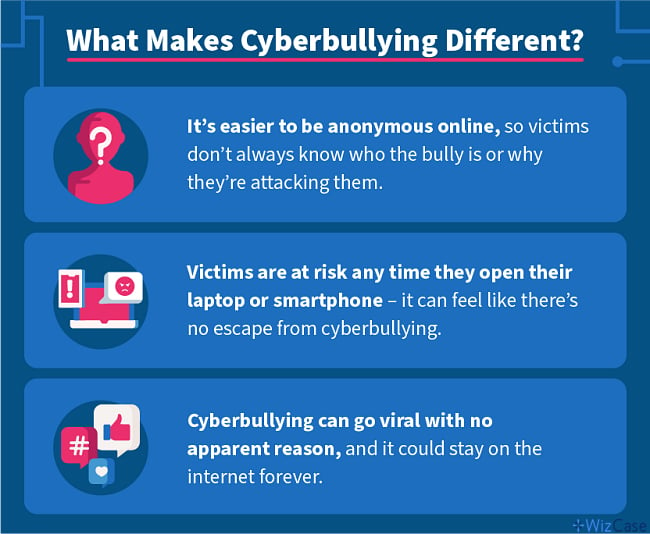
What Does Cyberbullying Look Like?
Most cyberbullying tends to take place when teens are around 15–17 years old, and can take the form of name-calling (32% of reports), false rumors (22%), and receiving explicit images (17%) or physical threats (10%), among others.
If your teenager is using a cellphone, then the risks of cyberbullying can be ever-present. All social media platforms are mobile-first these days; which encourages kids to be online more.
It often happens in public online spaces where the bully is anonymous, but the victim is not. It can also happen in semi-public online spaces, like big WhatsApp groups, where it may look like exclusion, constant teasing, and mean and abusive comments.
Victims will continue to suffer the effects of these incidents long after the anonymous bullies have moved on. Bullies may be posting rumors or hateful comments about victims which can stay online for years, despite moderation policies in place on popular platforms.
Each incident and its effects can be quite unique, and what cyberbullying looks like is constantly changing. But parents have a fantastic resource available to help them learn more: their kids.
TIP: Finding Out What Cyberbullying Looks Like for Your Children
After you’ve helped your kids understand what cyberbullying is, ask them for examples or specific behaviors that they’ve seen or heard. If you use different social media platforms or play different games than they do, there’ll be lots to learn!
There are also a few common types of cyberbullying. Understanding what these are can help you know what to look out for. It can also help you to start a conversation with your children about what they experience when using the internet.
A broad category of online bullying is when one person uses any electronic communication to send repeated messages to another person with the intention to harass or upset that person.
This kind of harassment can cause a lot of distress for victims. It’s made easy for bullies because of digital media’s unique capacity for frictionless, immediate communication.
“Doxing” is another very common type of cyberbullying to look out for. This is where bullies find out a target’s identity and personal information, and share it on a public forum. This might be done by people your child would never meet in person.
The information they might share can include the victim’s: full name and address, phone number, email address, social media accounts, and more.
More than 1 in 10 teenagers in a sample of 2,000 Hong Kong students admitted to having taken part in a doxing campaign at some point in their lives.
Trolling—behavior intended to provoke or offend people to get a reaction—can turn into cyberbullying when it’s repeatedly targeted at the same person.
Platforms with more anonymity (e.g. Reddit and Discord) are linked with a higher risk of cyberbullying for users.
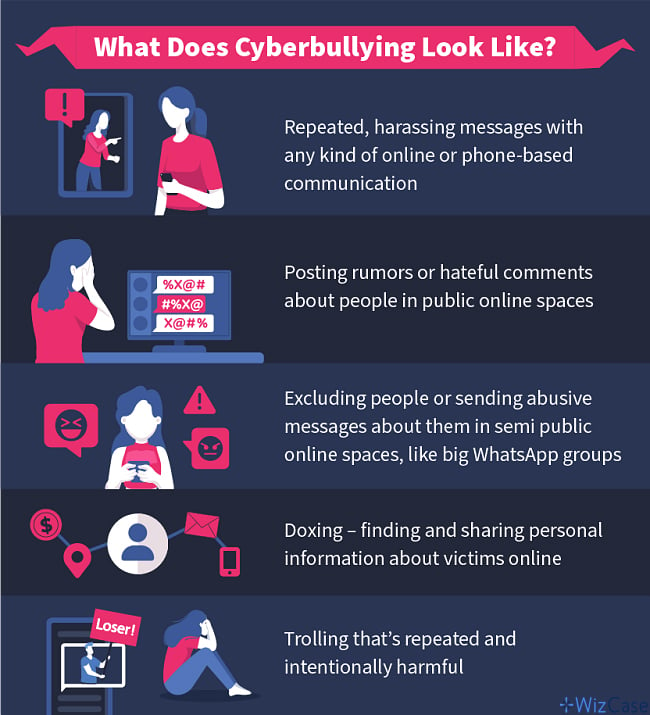
These are some of the ways that cyberbullying can happen today, but it’s worth repeating that the specific modes of bullying are constantly changing. Parents need to talk to their kids to understand exactly how cyberbullying affects them.
Some Children Are More Vulnerable Than Others
Children of both sexes are similarly affected by cyberbullying. In the US, 54% of girls and 44% of boys aged 15 to 17 report having experienced cyberbullying at some point.
But, the way it happens is different. One-quarter (25%) of girls in this age group have received unsolicited explicit images, compared to 18% of boys.
Young people are more vulnerable to cyberbullying if they belong to certain minority groups.
This is especially true for sexual minorities. Research shows that LGBTQ+ young people are 50% more likely to be victims of cyberbullying than straight peers.
Young people with disabilities, especially special educational needs and developmental disorders, are also more likely to be victims of cyberbullying than others.
In the UK, nearly a fifth of children aged 9 to 16 have experienced cyberbullying, but this increases by 12% for children with special educational needs. In a survey of children with autism in the UK, 63% reported that they had been bullied.
The Effects of Cyberbullying
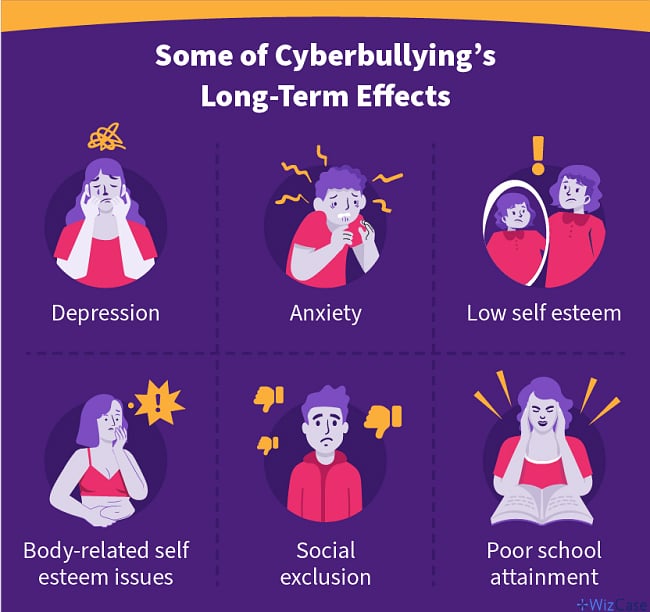
Cyberbullying has known negative impacts on victims’ emotional and mental well-being. Children who get bullied might perform worse at school. That’s not to mention the increased risk of anxiety, sleep difficulties, and depression.
Fifteen years’ worth of research has shown that teenagers who have been involved in cyberbullying—both victims and perpetrators—struggle more with their studies, emotions, psychological development, and behavior.
Cyberbullying victims are more likely to suffer body-related self-esteem issues than victims of in-person bullying.
Research based on data from hundreds of German-speaking youth suggests that there is a reciprocal relationship between depression and cyberbullying victimization. In other words, depression can be a predictor for future cyberbullying, and cyberbullying can lead to depression. The same is true for anxiety.
Tragically, there is also an observable higher risk for suicidal ideation and suicide attempts for victims of cyberbullying.
The consequences of cyberbullying for your child will be unique to their situation.
They may respond to cyberbullying by avoiding certain groups online, or even in person. Or they might have low confidence about a specific task or aspect of their life. Again, the best way to understand what’s going on is to speak with your child.
What Parents Can Do About Cyberbullying
Fortunately, parents have a significant role to play to help prevent cyberbullying.
Educating their children on how to behave appropriately online is a good first step, but it needs to be backed up by ongoing discussions.
Take the time to speak with your child about what they get up to online. Encouraging them to share their experiences with you frequently will open up the lines of communication, which can help you spot the signs of cyberbullying early on.
While opening the lines of communication can help to prevent your child from becoming involved in cyberbullying on either side—as victim or offender—it isn’t without its challenges.
When surveyed, nearly all (96%) parents said that their child hadn’t been harassed or bullied online. However, just more than half (57%) were confident that their child would tell them if they were.
Given that 46% of teens are cyberbullied, many parents’ concerns about being unaware of their child’s victimization seem to be justified.
Now, anyone with teenagers will know that it’s not necessarily easy to get them to open up. But victimized teens still need to know that they could bring up hurtful interactions with their parents if they need to.
If your child isn’t keen to talk to you, you can also guide them towards in-person and online support networks, where they can share their experiences with others who have been affected by cyberbullying and get the help they need.
TIP: Support Networks
Helping to make sure your child has a wide support network around them—on- and offline—is a great way to tackle cyberbullying preemptively. The more people your child or teenager trusts and feels safe around means more opportunities for them to open up about problems.
A simple, yet effective, strategy for reducing the likelihood of your child being cyberbullied is to restrict their access to the internet. Parental controls are useful here.
These controls allow you to restrict the sites that your child can access. They can be implemented at the internet service provider level, which means that all devices that use your home internet will be restricted.
There are also a number of native parental controls that you can activate on your child’s smartphone. These controls will let you restrict access to or set time limits for specific apps. There are also third-party apps that will notify parents about suspicious or harmful messages.
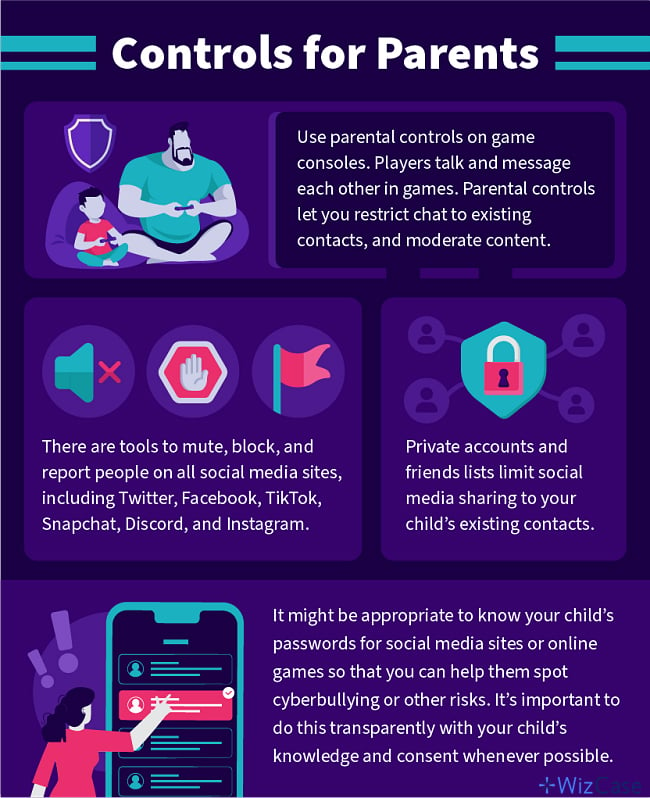
Using Social Media Safely
In 2021, a series of leaks from the Meta head offices showed that the social media giant is not only fully aware of the harm that cyberbullying causes on its platforms (which include Facebook, Instagram, and WhatsApp), but that it also seems apathetic toward removing it.
This goes to show that you can’t rely on tech giants to protect your kids from cyberbullying on their platforms.
Fortunately, there are some tools embedded into these platforms that help you and your child use social media (relatively) safely.
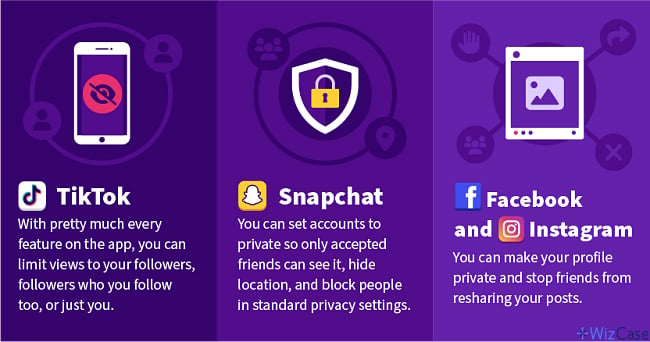
The best way to keep cyberbullies out of your child’s social media world is to make their profile private and help them limit their contacts to trusted friends only.
Preventing Your Child from Cyberbullying Others
When exploring what parents can do about cyberbullying, it’s important to remember that you also have a responsibility to prevent your children from cyberbullying others.
Your relationship with your child affects the likelihood that they might become a cyberbully. One of the most effective deterrents for potential cyberbullies is a child’s perception that they will be punished or disappoint their parents.
Again, regular and open communication with your kids about what they do and who they talk to online is the best remedy here. Collaboratively setting ground rules for how to behave online is another great way to instill the values that you want in your children.
Directly monitoring your child’s accounts can work, but creating an open environment in your home where your kids feel comfortable browsing their apps and sites in your company can be even more effective.
Keeping a family computer in a shared space with the screen visible to passersby is a good way of passively supervising your kids online. You can ask them to show you what they’ve found on social media that day; for example, things that they found funny or interesting.
How to Care for a Cyberbullying Victim
The truth is, a lot of what parents can do about cyberbullying might not be necessarily well-received by their children.
You’ll need to work together with your child to make a plan for dealing with this issue. Getting their perspective and understanding their unique situation is essential for effectively tackling the problem.
Open communication will also help them understand why you’re making certain interventions in their online activities, and will hopefully help them to get on board with your plan.
TIP: Talk About Cyberbullying
- Speak to your child directly if you’re concerned that they might be a victim of cyberbullying.
- Think about speaking to teachers or the cyberbully’s parents directly.
- Give your child opportunities to speak with other trusted adults themselves.
It might be necessary to involve professionals like school teachers or coaches. Other adults in your family can also be a great resource for helping your child feel safe to open up about cyberbullying.
These third parties can help to mediate or settle a problem, or they can simply give your child an opportunity to talk to a trusted adult and get another perspective outside of yours.
Depending on the situation, it might help to speak with the parents of the cyberbully directly.
Where the situation has escalated beyond these interventions being helpful, involving law enforcement may be an option.
How to Handle a Cyberbullying Problem
This cyberbullying guide for parents wouldn’t be complete without some practical steps that you can take to tackle the issue.
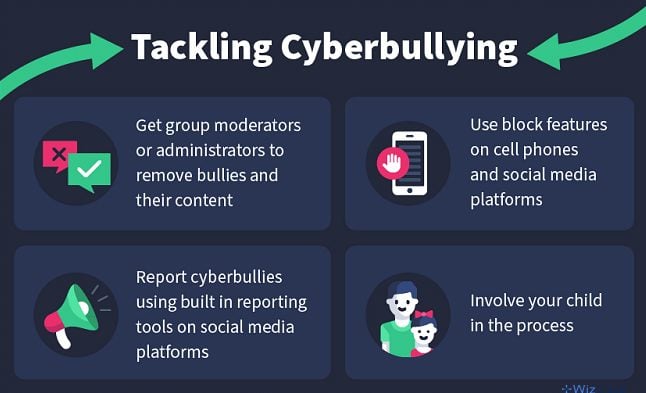
Moderators and administrators can remove or restrict cyberbullies on platforms that they run. Private groups’ moderators will usually respond well if you reach out to them about cyberbullying in their group.
Social media platforms also have moderation policies in place to tackle cyberbullying. Reporting cyberbullying with built-in features on these platforms doesn’t always get results, but it can lead to a ban or restriction for continually abusive accounts.
As well as bans or user restrictions for cyberbullies, you can ask for posts to be deleted from the platform (but be aware that once something has been posted publicly there’s no knowing where it could be saved and reposted).
Your child’s cell smartphone has block features as well. You can block calls and texts to and from specified numbers, email addresses, and social media platforms.
TIP: Make Sure You’re Not Inadvertently Punishing Your Child
While it might seem like a good idea to simply block all accounts and take away their smartphone in an effort to prevent cyberbullying, this is usually not the best solution.
This unfortunately does nothing to address the real problem and can be a form of punishment for your child or teenager, even though they’ve done nothing wrong.
Rather, look to address the core cyberbullying issue itself. It will not go away if it is ignored.
It is also very important to be as transparent as possible with your child. If you organize a meeting with school authorities and the children find out, it could lead to further marginalization. Involve them in the process of tackling their cyberbullying problem as much as possible.
Helping Your Child Recover from Cyberbullying
Having cyberbullying posts taken down or helping your child block a bully are just the first steps in dealing with cyberbullying. There will still be a fair bit of help and support you’ll need to give your child.
Cyberbullying victims say that the thing that helps most is simply when they are listened to by other people. This helps them to release trapped emotions.
TIP: Making Sure Victims Don’t Feel at Fault
Reinforce with your child that being the victim of cyberbullying is not their fault and there is a lot of help out there for them. If the victim believes they are at fault, it could be more likely to happen again.
Responses to Cyberbullying
Cyberbullying is increasingly being recognized as a serious problem for kids and teenagers. This is good news, as authorities, schools, youth organizations, and technology platforms are working to tackle it.
As parents, you want to know that the institutions that you trust your children with are going to keep them safe.
Speaking with professionals who have a duty of care for your child to gauge their understanding and approach to cyberbullying, checking out school policies, and lobbying social media firms and tech giants to moderate their platforms better are all proactive steps you can take as a parent to help keep your children safe.
Lobbying local politicians, school boards, and police departments to take cyberbullying seriously is another proactive way that parents can tackle cyberbullying.
TIP: Getting Evidence
One of the upsides of cyberbullying is that it’s relatively straightforward to get evidence. Take screenshots of the harmful content or messages and save them. This will ensure that you have everything you need on hand when taking the issue up with professionals or other adults.
At the platform level, AI and machine learning are being used to carry out the bulk of the work required to tackle cyberbullying.
But these systems don’t guarantee safety. Bans are easily circumvented, especially on anonymous platforms. Reports are often wrongly categorized. Plus, there are often too few human moderators to verify the effectiveness of these models.
Additional Resources
Our cyberbullying guide for parents is a great starting point for anyone wanting to protect their child against online abuse, but it’s far from the only useful resource that can aid you in this effort.
How to Stop Cyberbullying, UNICEF
UNICEF is backed by the United Nations and has a remit to keep children’s rights on the global agenda. The organization is committed to research and delivering practical solutions for children.
The home page for UNICEF’s extensive cyberbullying campaign is packed full of links to resources. The body worked with international experts in cyberbullying and child protection and partnered with TikTok, Instagram, Facebook, and Twitter to put these resources together.
StopBullying.gov, US Government
This official website from the US government contains lots of practical resources like templates, visual cues, and reliable advice.
The site is a US-specific cyberbullying guide for parents, families, and children.
Bullying and Cyberbullying, NSPCC
The National Society for the Prevention of Cruelty to Children (NSPCC) is a UK charity that has published extensive advice for parents and carers to help safeguard children from bullying and cyberbullying.
This resource includes UK hotlines and emergency contacts, strategies for identifying cyberbullying, and places where parents and carers can access support.
European Anti-Bullying Network
The European Anti-Bullying Network (EAN) fights bullying in Europe by lobbying governments and the EU, publishing and promoting scientific research, and creating anti-bullying materials, networks, and events with European partners.
Cyberbullying Research Center
This US-based non-profit is dedicated to researching and tackling cyberbullying.
The website hosts extensive resources, lists of services, and links to the latest reliable research on cyberbullying.
The Complete Online Guide to Parental Controls, WizCase
What parents can do about cyberbullying is often determined by the tools they have at their disposal. Our comprehensive guide to pretty much every parental control available.
Sources
- Adolescents and Cyberbullying: The Precaution Adoption Process Model – John Chapin
- A Majority of Teens Have Experienced Some Form of Cyberbullying – Pew Research Center
- Analysis and detection of labeled cyberbullying instances in Vine, a video-based social network – Rahat Ibn Rafic, et al.
- Approaches to Automated Detection of Cyberbullying – Semia Salawu, Yulan He, and Joanna Lumsden
- Autism and Bullying – Anti-Bullying Alliance
- Bullying During the COVID-19 Pandemic – Cyberbullying Research Center
- Children and Parents: Media Use and Attitudes Report 2023 – The Office of Communications (UK)
- Children‘s online behaviour in England and Wales: year ending March 2020 – ONS
- Cyberbullying Continues to Rise among Youth in the United States – Cyberbullying Research Center
- Cyberbullying – Megan A. Moreno
- Cyberbullying in 2021 by Age, Gender, Sexual Orientation, and Race – Cyberbullying Research Center
- Doxing: What Adolescents Look for and Their Intentions – Mengtong Chen, Anne Shann Yue Cheung, and Ko Ling Chan
- Deterring Teen Bullying: Assessing the Impact of Perceived Punishment From Police, Schools, and Parents – Justin W. Patchin and Sameer Hinduja
- Frequency of internet use, population counts, by age group, Great Britain, 2020 – ONS
- Learning Disabilities, Autism and Internet Safety – Cerebra
- Longitudinal Associations Between Cybervictimization and Mental Health Among U.S. Adolescents – Chad A. Rose and Brendesha M. Tynes
- Mobile Fact Sheet – Pew Research Center
- Online bullying in England and Wales: year ending March 2020 – ONS
- Online Nation 2023 Report – The Office of Communications (UK)
- Parenting approaches and concerns related to digital devices – Pew Research Center
- Perpetration and Victimization in Offline and Cyber Contexts – Christoph Burger and Lea Bachmann
- School bullying before and during COVID-19 – Tracy Vaillancourt, et al.
- Social Influences on Cyberbullying Behaviors Among Middle and High School Students – Sameer Hinduja and Justin W. Patchin
- Teens and Cyberbullying 2022 – Pew Research Center
- Teen Life on Social Media in 2022 – Pew Research Center
- Teens, Social Media and Technology 2022 – Pew Research Center
- Teens, Social Media and Technology – Pew Research Center
- Teens’ Social Media Habits and Experiences – Pew Research Center
- The Overlap Between Cyberbullying and Traditional Bullying – Tracy E. Waasdorp and Catherine P. Bradshaw
- The Facebook Papers: What you need to know about the trove of insider documents – NPR
- Towards understanding cyberbullying behavior in a semi-anonymous social network – Homa Hosseinmardi, et al.
- What is Cyberbullying – Cyberbullying Research Center
Attention: WizCase owns the visual and written content on this site. If our cybersecurity insights resonate with you and you wish to share our content or visuals, we ask that you credit WizCase with a link to the source in recognition of our copyrights and the diligent work of our expert cybersecurity researchers.




Leave a Comment
Cancel